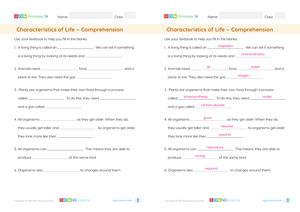Begin the lesson by introducing the concept of organisms and their basic needs. Discuss how living things like plants, animals, fungi, and humans share common characteristics that define them as organisms.
Go to the LessonLearning Objectives
- Identify and describe the basic needs of organisms, including air, water, food, and a place to live.
- Explain the process of photosynthesis and its importance for plant survival.
- Understand how organisms grow, reproduce, and respond to environmental changes.
- Recognize the role of movement in organisms and how it differs between plants and animals.
- Describe the cellular composition of organisms and the functions of cells in growth, reproduction, and response to the environment.
Introduction and Hook
Engage students with a brief discussion on how organisms respond to their environment, setting the stage for exploring these characteristics in depth.
Direct Instruction
Explain the basic needs of organisms, including air, water, food, and a place to live. Highlight the process of photosynthesis and its importance for plant survival.
Guided Exploration
Facilitate a discussion on how organisms grow, reproduce, and respond to environmental changes. Use examples from both plant and animal kingdoms.
Hands-On Activity
Engage students in a hands-on activity by having them classify organisms found in their schoolyard. Use hand lenses to examine small organisms and discuss their characteristics and needs.
Independent Practice
Check for Understanding
Conduct a class discussion to review key concepts covered in the lesson. Ask students to share examples of organisms and their characteristics.
Review and Reflection
Encourage students to reflect on what they have learned about the characteristics of life. Have them write a short paragraph summarizing their understanding.
Assessment and Extension
Test students' comprehension with the 'Review – Classification of Organisms' assessment, which covers classification, needs of plants and animals, and understanding of unicellular and multicellular organisms.
Try the QuizFor further exploration, encourage students to research different organisms and present their findings to the class. This extension activity promotes independent learning and critical thinking.







